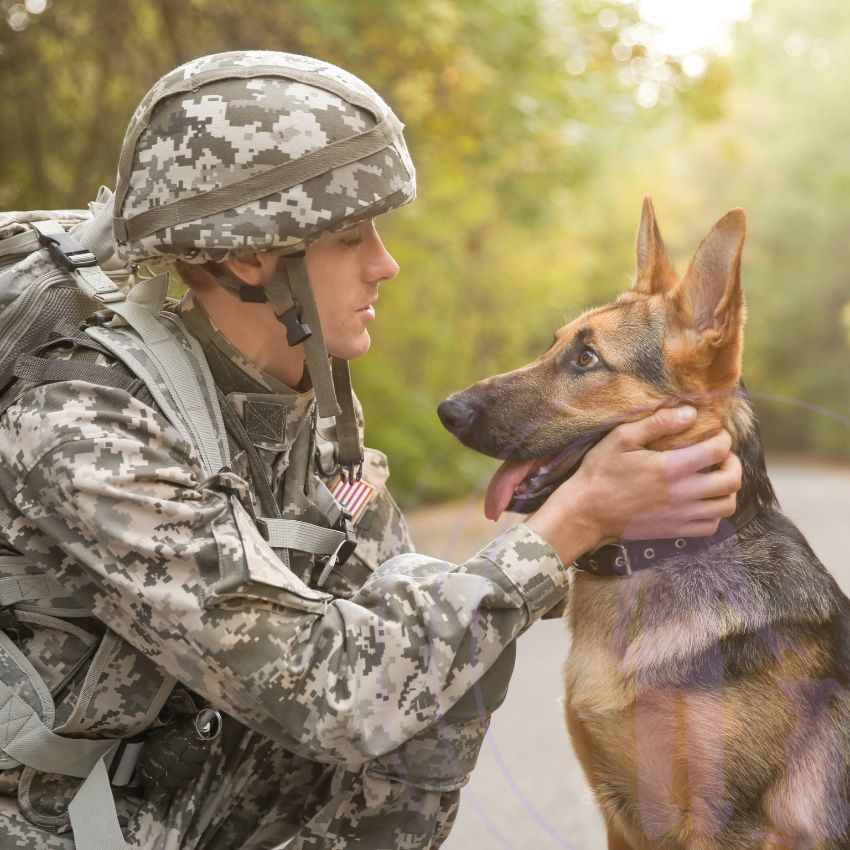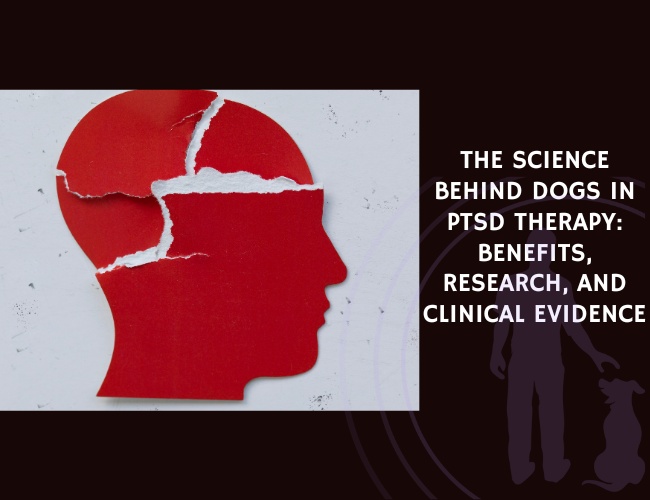Understanding PTSD and the Role of Canine Therapy
Definition and Symptoms of PTSD
Post-Traumatic Stress Disorder (PTSD) is a severe mental health condition that arises after an individual experiences or witnesses a traumatic event. The impact of PTSD can be pervasive, significantly disrupting various aspects of daily life. Here are some of the key symptoms associated with PTSD:
- Intrusive Thoughts and Flashbacks: Individuals with PTSD often find themselves reliving the traumatic event. These can manifest as vivid memories during the day or as nightmares during sleep, causing significant distress and anxiety.
- Hyperarousal: This symptom includes an exaggerated startle response, irritability, heightened anxiety, and difficulty sleeping. Individuals may feel constantly on edge, which can make everyday activities challenging.
- Emotional Numbness: Many with PTSD struggle with feeling emotionally detached or numb. This can lead to significant difficulties in maintaining social relationships and engaging in daily activities.
These symptoms can severely impair a person’s quality of life, negatively impacting their social relationships, work, and general well-being.
Three Main Types of Support Dogs
Support dogs play a pivotal role in helping individuals manage PTSD symptoms. There are three main types: service dogs, therapy dogs, and emotional support animals (ESAs). Each type plays a unique role and comes with distinct legal rights.
Service Dogs
- Training: Service dogs undergo rigorous training to assist individuals with PTSD. They are trained to perform specific tasks such as interrupting anxiety episodes, providing physical grounding during flashbacks, and waking their owners from nightmares.
- Legal Rights: Under the Americans with Disabilities Act (ADA), service dogs have the right to accompany their owners in public spaces. This includes places where pets are generally not allowed, such as restaurants, hospitals, and airplanes.
Service dogs offer tailored support, making them an invaluable resource for individuals struggling with PTSD’s most challenging symptoms.
Therapy Dogs
- Role: Therapy dogs provide emotional support and comfort specifically during therapy sessions. They do not perform specific tasks for their handlers but offer a calming presence that aids in reducing stress and anxiety.
- Usage: These dogs are commonly found in hospitals, clinics, and support groups. Their role is to facilitate a supportive environment during therapeutic engagements.
Therapy dogs are vital in creating a comforting and supportive space, helping clients feel more at ease and open during therapy sessions.
Emotional Support Animals (ESAs)
- Definition: ESAs offer companionship and help alleviate symptoms of anxiety and depression. Unlike service dogs, they are not trained to perform specific tasks.
- Legal Status: While ESAs can be a huge source of emotional comfort, they do not have the same legal rights as service dogs. A prescription from a mental health professional is needed to qualify an animal as an ESA, but they are not granted public access rights.
ESAs are primarily there to provide consistent companionship, which can be incredibly comforting for someone managing PTSD.
Distinction Between Different Roles and Legal Rights of Each Type of Support Dog
Understanding the distinct roles and legal rights of each type of support dog is crucial for adequately leveraging their benefits.
- Service Dogs: They are highly trained to perform specific tasks and have the broadest legal access under the ADA. This means they can accompany their owners into almost all public and private spaces.
- Therapy Dogs: These dogs work primarily in therapeutic settings and do not have public access rights outside these specific environments. They can often be found in hospitals or counseling sessions, providing emotional support.
- Emotional Support Animals (ESAs): ESAs provide companionship and emotional support without specific task training. Their rights are limited compared to service dogs. They have some housing and travel protections but do not have public access rights.
These distinctions are essential for ensuring that the appropriate type of support dog is matched with an individual’s needs and for understanding the legal protections and limitations involved.
Chapter 2 will delve into the diverse and transformative therapeutic mechanisms and benefits experienced with canine-assisted therapy. This will enhance our understanding of the remarkable physiological, psychological, and behavioral improvements offered through our faithful companions.
Therapeutic Mechanisms and Benefits
Neurobiological Effects
When it comes to understanding how dogs help individuals with PTSD, one cannot overlook the significant neurobiological effects they have. The presence and interaction with dogs can bring about profound changes in brain chemistry.
Firstly, spending time with dogs increases the levels of oxytocin, a hormone often referred to as the “love hormone” or “bonding hormone.” This surge in oxytocin helps in reducing stress levels and facilitates trust and bonding, creating a calming effect on individuals with PTSD. Additionally, serotonin levels are also raised. Serotonin plays a crucial role in mood regulation, and higher levels are associated with feelings of well-being and happiness.
Moreover, engagement with therapy dogs has been shown to reduce cortisol levels in PTSD patients. Cortisol is a stress hormone, and its reduction indicates lower stress and anxiety levels. By prompting the release of these beneficial neurochemicals, dogs offer a unique form of therapeutic assistance.

Psychological Benefits
Dogs do more than just change our brain chemistry; their presence also yields significant psychological benefits.
One of the key advantages is the reduction of anxiety. Many individuals with PTSD face constant fear or worry. The companionship of a dog provides a sense of safety and stability, thereby lowering anxiety levels. This calming presence can translate into improved sleep quality, as service dogs can wake individuals during nightmares, minimizing sleep disturbances and promoting more restful sleep.
Furthermore, dogs enhance social interaction. People with PTSD often struggle with social withdrawal and isolation. Owning and caring for a dog offers opportunities to engage with the community. Whether it’s through casual dog walks or more structured therapy sessions, dogs serve as social catalysts, helping individuals rebuild social connections and boost their confidence in interacting with others.
Behavioral Improvements
Beyond the psychological and physiological advantages, dogs also promote positive behavioral changes in individuals with PTSD.
Developing a relationship with a therapy dog or service dog can significantly enhance an individual’s daily routine. Having a dog means engaging in regular activities such as feeding, walking, and grooming the dog. These structured routines help provide a sense of purpose and can significantly improve mood. Individuals may find that the responsibilities associated with dog care reduce feelings of aimlessness and enhance their sense of accomplishment.
Physical activity naturally becomes a part of life with a dog. Regular walks and playtime ensure that individuals engage in physical exercise, which has well-documented mental health benefits. Physical activity not only improves physical health but also boosts mental well-being through the release of endorphins, the body’s natural mood enhancers.
Dogs also promote mindfulness. Activities like walking, petting, or playing with a dog require the individual to be present in the moment, encouraging mindfulness and reducing the tendency to dwell on negative thoughts or past traumas. By providing non-judgmental companionship and engaging individuals in these positive activities, dogs facilitate significant behavioral improvements.
The multidimensional benefits that dogs offer to individuals with PTSD make them invaluable assets in therapeutic settings. Their impact spans across neurobiological, psychological, and behavioral domains, providing comprehensive support that enhances overall quality of life. Moving forward, we must consider both the practical aspects of implementing canine therapy programs and the ongoing research that supports their efficacy.
Clinical Evidence and Research Findings
Results from Studies Showing Reduced Symptoms in Veterans with Service Dogs
Post-Traumatic Stress Disorder (PTSD) is a complex condition that significantly impacts the lives of those who suffer from it. One of the pioneering breakthroughs in managing PTSD symptoms comes from the use of service dogs. Numerous studies have demonstrated the profound benefits these specially-trained canines offer.
Study 1: Effects of Service Dogs on Veterans with PTSD
A landmark study evaluated the impact of service dogs on veterans diagnosed with PTSD. Results showed that veterans paired with service dogs experienced significant reductions in anxiety and depression. Sleep disturbances, a common issue for those with PTSD, also saw noticeable improvements. Veterans reported feeling more grounded and less isolated, thereby improving their overall quality of life.
Therapy Dog Program Outcomes in Clinical Settings
Therapy dogs differ from service dogs in that they offer emotional support and comfort during therapy sessions rather than performing specific tasks. Their presence in clinical settings has been linked to improved therapeutic outcomes.
Study 2: Comparison of Therapy Dog Programs in Clinics
A comparative study investigated the effectiveness of therapy dog programs in various clinical settings. Patients receiving therapy with the support of these dogs reported higher satisfaction levels and reduced stress during sessions. The study highlighted the emotional connection between patients and therapy dogs as a crucial factor in patient recovery.
These programs are increasingly being integrated into mental health clinics where they facilitate a safe and comforting environment, ultimately fostering a more engaging treatment experience.
Survey Data Demonstrating Reduction in Medication Dependency and Improved Patient Engagement
Quantitative survey data further supports the effectiveness of canine-assisted therapy in PTSD treatment. Patients engaging with therapy or service dogs reported notable reductions in their reliance on medication.
- Medication Dependency: Many patients found that regular interaction with a therapy dog decreased their need for antidepressants and anxiolytics. This serves as an important consideration for managing PTSD with fewer side effects and dependencies.
- Patient Engagement: Surveys also revealed that the presence of therapy and service dogs improved overall patient engagement in their treatment programs. Patients were more likely to attend sessions, participate actively, and show a greater commitment to their therapeutic processes.
Real-World Case Studies
The efficacy of canine-assisted therapy extends beyond controlled studies and clinical trials, with real-world case studies showcasing its transformative impact:
- Veterans and Service Dogs: A combat veteran who was paired with a service dog reported remarkable improvement in managing PTSD symptoms. The dog’s ability to interrupt anxiety episodes and provide comfort during flashbacks dramatically enhanced the veteran’s daily life.
- Therapy Dog Programs in Clinics: A mental health clinic incorporated therapy dogs into group sessions for patients with PTSD. The results were overwhelmingly positive, with enhanced therapeutic outcomes and increased patient engagement.
- Children and PTSD Therapy Dogs: Therapy dogs have also been instrumental in helping children who have experienced trauma. These dogs offer a sense of safety that encourages children to open up during therapy sessions, illustrating the versatility and broad applicability of canine-assisted therapy.
As we can see, the role of dogs in managing PTSD is not only supported by robust clinical evidence but also by tangible real-world successes. The potential for canine-assisted therapy to revolutionize PTSD treatment is vast, involving collaboration between mental health professionals, dog trainers, and patients.
By understanding these clinical findings and the substantial evidence backing canine-assisted therapy, we can better appreciate the significant role that service and therapy dogs play in improving the lives of those with PTSD. This foundational knowledge sets the stage for discussing how these therapeutic interventions can be practically implemented, and how we can navigate the challenges posed by their widespread adoption.
Implementation and Best Practices
Selecting Appropriate Dog Breeds
Choosing the right breed is crucial for the success of canine-assisted therapy. Labrador Retrievers, Golden Retrievers, and German Shepherds are commonly favored due to their calm temperament and high trainability. These breeds are known for their loyal and friendly nature, which is essential for individuals with PTSD.
- Labrador Retrievers: Known for their patience and gentleness, Labradors are excellent at providing emotional support.
- Golden Retrievers: Their friendly and tolerant attitude makes them great companions.
- German Shepherds: Highly intelligent and easy to train, these dogs are adept at performing specific tasks to aid PTSD management.

Training Requirements and Certification Processes
Training a service or therapy dog requires time and dedication. Here’s a breakdown of the training processes:
Service Dogs
Service dogs undergo intensive training, often lasting 1-2 years, to perform tasks specific to PTSD management. Tasks include:
- Interrupting anxiety episodes
- Providing physical grounding during flashbacks
- Waking individuals from nightmares
The certification of service dogs ensures that they meet the high standards required to assist individuals effectively. This training includes:
- Basic Obedience: Ensuring the dog can follow commands and behave well in various environments.
- Specialized Training: Teaching the dog to recognize and respond to the specific needs of individuals with PTSD.
- Public Access Test: Evaluating the dog’s behavior in public places to ensure it can navigate these environments without causing disruptions.
Therapy Dogs
Therapy dogs, while not as highly trained as service dogs, still require rigorous obedience training to be effective in therapeutic settings. Certification processes typically involve:
- Basic Training: Basic commands and proper behavior in therapy environments.
- Therapy Certification: Ensuring the dog is well-behaved around various individuals and can handle the therapeutic environment.
Guidelines for Effective Therapy Programs
Implementing a successful therapy program involves collaboration between mental health professionals, dog trainers, and the individuals receiving therapy. Here are some key guidelines:
Collaboration with Mental Health Professionals
Developing a structured therapy program that integrates the use of therapy dogs requires close collaboration with mental health experts. These professionals can:
- Assess the specific needs of the individuals
- Tailor therapy sessions to incorporate the presence and activities with the dog
Maintaining Dog Welfare
The wellbeing of therapy dogs is paramount. To ensure the dogs are well-treated and not overburdened by their roles:
- Regular Vet Checkups: Ensure dogs remain healthy and fit for their tasks.
- Managed Work Hours: Limit the hours dogs work each day and ensure they have ample rest and playtime.
- Ethical Treatment: Always use humane training methods and show respect for the dog as a member of the therapy team.
Creating a Structured Routine
Establishing a structured daily routine is beneficial for both the dog and the individuals receiving therapy. This routine should involve:
- Regular Feeding and Exercise: Keeping the dog healthy and energetic.
- Consistent Training Sessions: Reinforcing the skills necessary for the dog to assist in therapeutic settings.
- Scheduled Therapy Sessions: Ensuring the therapy dog is well-rested and ready to provide support during therapy.
By adhering to these guidelines and practices, one can harness the full potential of canine-assisted therapy. Providing structured, humane, and well-coordinated care ensures that both the individuals with PTSD and the therapy dogs thrive in their roles.
Ensuring continuity and maintaining high standards is essential for the growth and success of canine-assisted therapy programs.
Challenges and Future Directions
Access Barriers
One of the most significant challenges in implementing canine-assisted therapy for PTSD is the issue of accessibility. The high costs associated with training service and therapy dogs can be prohibitive for many individuals in need. Obtaining a trained service dog typically requires substantial financial investment, ranging from $20,000 to $30,000. This can include costs related to the dog’s purchase, training, and certification. Additionally, the high demand for these trained animals often leads to long waiting periods, sometimes extending up to two years.
Another access barrier is the availability of trained service and therapy dogs. The number of organizations that provide these specialized dogs is limited, and the rigorous training process means that each organization can only produce a certain number of dogs per year. This shortage makes it difficult for many individuals, especially those in urgent need, to access the therapeutic benefits these animals provide.
Research Needs in Long-Term Effectiveness
Understanding the long-term effectiveness of canine-assisted therapy for PTSD is crucial for validating its benefits and improving program efficacy. While many studies demonstrate short-term improvements in symptoms, there is a need for longitudinal studies that track the impacts of therapy dogs over several years. Such research would provide insights into how sustained interaction with a therapy dog affects PTSD symptoms and overall quality of life.
In addition to long-term studies, there is also a need to explore the genetic and behavioral traits that make certain dogs better suited for PTSD therapy. Research into the genetic markers that correlate with calm temperament, trainability, and empathy could help refine the selection process for therapy dogs. This could lead to a higher success rate in treatment outcomes and more efficient training programs.
Potential of Virtual Canine-Assisted Therapy
With advancements in technology, exploring virtual or robotic alternatives to live therapy dogs presents an intriguing potential for canine-assisted therapy. Virtual or robotic therapy dogs could serve as a supplementary tool or an alternative for those unable to access live dogs due to allergies, phobias, or logistical constraints. Early studies suggest that interaction with robotic pets can evoke emotional and psychological responses similar to those elicited by real animals.
Implementing virtual canine-assisted therapy in therapeutic settings could also reduce the costs and waiting periods associated with training and maintaining live therapy dogs. These virtual tools could be particularly beneficial in remote areas or regions with limited access to trained therapy animals.

Policy Development
Increasing access to service dogs for PTSD patients requires thoughtful policy development and advocacy. Legislative efforts should focus on increasing funding for training programs and providing financial assistance to those in need. Policies that standardize the certification process for service and therapy dogs would also help ensure that all individuals receive high-quality support.
Advocating for policies that clarify the legal rights and protections of therapy dogs, service dogs, and emotional support animals (ESAs) is essential. Clear guidelines would help prevent confusion and ensure that individuals with PTSD can access the support they need without unnecessary legal obstacles.
In summary, addressing the challenges and exploring the future directions of canine-assisted therapy for PTSD involves overcoming access barriers, conducting long-term research, considering virtual alternatives, and developing supportive policies. By tackling these areas, we can enhance the implementation and effectiveness of therapy programs, ultimately helping more individuals benefit from the therapeutic bond with a canine companion.









